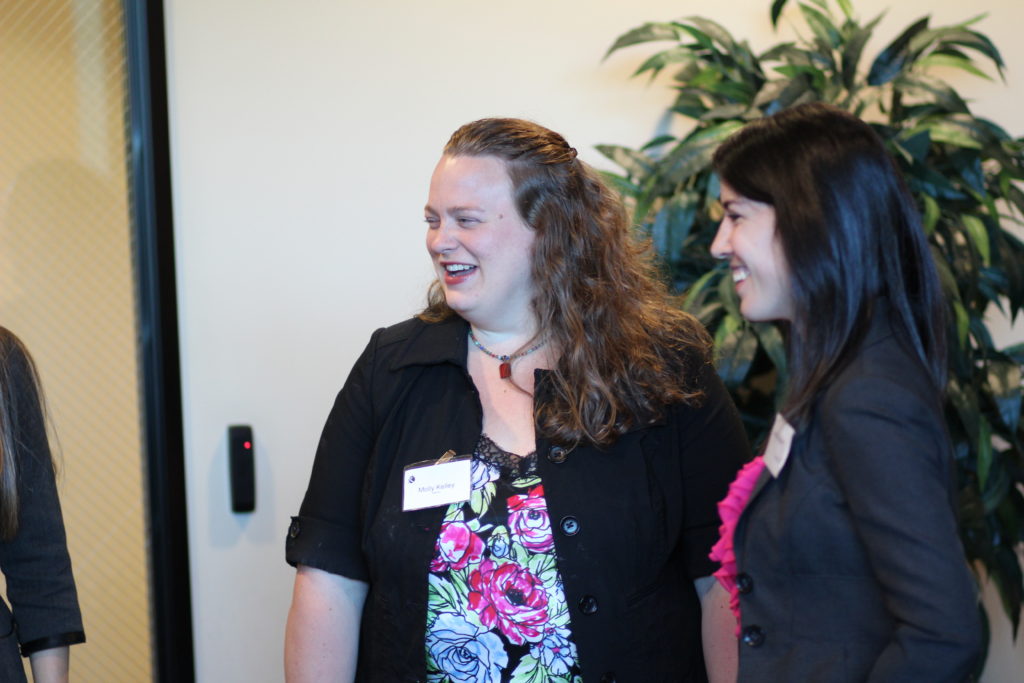Subscribe via iTunes | Download the MP3 | Running Time: 25:09
The onboarding process can have a significant impact on whether or not new employees “make it” in their new role. So what is onboarding, and why are employers talking about it more and more in their HR practices?
Brandon Laws sits down with Molly Kelley of Xenium HR to discuss the traditional onboarding process and how employers are shifting to new, innovative onboarding practices to make sure employees properly onboard into their role and company culture.
In this episode, Molly shares great takeaways for listeners and actionable items that can jump-start the onboarding process in any organization.
![]()
Brandon: Welcome back, everybody. We are here for another podcast, my name is Brandon Laws and I am your host. Today with me I have Molly Kelley, who is an expert in human resources and has been on the podcast several times. We’re happy to have her back!
Molly: Thank you, Brandon! I love being here.
Brandon: Today we’re going to talk about onboarding. You have developed what I think is a fantastic training on this topic and what we’re going to do today is expand on it and give listeners a high-level overview of what onboarding is and what it means. Let’s dive in—what is onboarding?
Molly: You know, what I’ve realized in doing a lot of research and work with our clients over the last eight years is that people have different definitions of onboarding. Orientation is what we typically think of as onboarding. Most companies, statistics show about 70% of all employers, are offering an orientation process. What that usually consists of is going through the hiring paperwork.
Brandon: The boring stuff.
Molly: The boring stuff! The “thou shalt not”, “darest thou not,” that kind of thing. It also might involve going over handbooks and looking at the job description, but often it’s pretty high level. That process typically happens with the HR Manager or Office Manager or someone like that.
Onboarding is a more comprehensive thought process around all of that. There are some companies out there that spend up to a year or a year and a half onboarding. It’s a recognition that an employee needs time and support to integrate into an organization that’s beyond signing some documents. So that’s kind of what we’re diving into here.
Brandon: That’s hard to get your head around, a year long process.
Molly: It is!
Brandon: That’s something that you’d generally think of as lasting the first week or something. So that’s a little different for people to hear if they’re not privy to the term.
Molly: There’s a great study out there we could recommend for listeners that was done by SHRM a few years ago. SHRM is the Society for Human Resources Management, so the study really focused on the fact that most people prioritize the Compliance pieces—getting the W4, completing the I9, and being able to pay this person. There are another three C’s, which was how they divided it up. In total there were the Four C’s of Onboarding, being Clarification, or what am I supposed to be doing, what’s my job, and how does it fit with the rest of the organization. Culture is a big huge piece of this—who are these people I’ve joined, what do we believe in, how do we act, how are we expected to treat each other, where’s my support avenue, what kinds of fun do we have, what’s the inner lingo, and things like that. And finally Connection, which is the relationships that are hopefully fostered through a good onboarding process where you’re hopefully having the employee mix with multiple folks within the organization before turning them loose to do their job.
doing, what’s my job, and how does it fit with the rest of the organization. Culture is a big huge piece of this—who are these people I’ve joined, what do we believe in, how do we act, how are we expected to treat each other, where’s my support avenue, what kinds of fun do we have, what’s the inner lingo, and things like that. And finally Connection, which is the relationships that are hopefully fostered through a good onboarding process where you’re hopefully having the employee mix with multiple folks within the organization before turning them loose to do their job.
Brandon: Let’s go back for a little bit. What’s your expertise in terms of onboarding? You basically built all this content, and you do this for clients. I know you’ve seen a lot of different perspectives. Could you give some background on all of this?
Molly: I have to say that unfortunately my expertise comes from the backend of offboarding people who have not been properly onboarded.
Brandon: Ah, so you see the flaws in not onboarding.
Molly: The full cycle, yes.
Brandon: It’s almost a better perspective.
Molly: It is. We do a lot of exit interviews here at Xenium for our clients. As an HR Business Partner I review those and try to give feedback to our clients to help shape culture and retain talent. I certainly sit in termination meetings at times and have conversations with employees who say, “Yeah, but I didn’t know that that was part of my job when you hired me. You didn’t tell me that was what I’d be doing.” Or “You didn’t train me, you didn’t spend time with me on this.” Lack of training is a common refrain we hear over and over again from folks who are exiting a company. And there are times when I sit there thinking to myself, I believe it. We didn’t set this person up for success.
There’s a whole hiring process. We have a training workshop at Xenium that’s basically about making a good hire, such that you bring somebody on and have them be successful. We have literally one slide in that training, at the very end, about onboarding. And that’s it. Up until February of last year, when I was asked to do a presentation on this topic, we didn’t have anything that addressed that gap between essentially that interviewing, hiring process and performance management. And there is a whole getting-to-know-you period and providing information on resources, culture and our community. That conversation really needs to be happening at every company.
Brandon: There are so many questions I want to ask you, but first: who’s involved in this process? Maybe for small companies it’s shorter, a month or two month process before they’re integrated. But a year seems realistic to fully ingrain them in the culture. Who’s involved in that whole process?
Molly: It depends on the size of the company. We do have organizations that we work with that don’t have in-house HR or are maybe relying heavily on Xenium to perform their HR functions so it falls to an Office Manager, CFO, Owner, or Hiring Manager a lot of times. What we like to see is a lot of involvement from the entire team that’s going to touch that position. You can picture it as a ripple effect—the broader you go, the more integrated and, frankly, engaged employees report feeling. So if they’re having a conversation with the president of the organization within that first week, it’s a completely different picture of the company than if they never interact with that individual. And I say this regardless of what level the employee is at. They could be the frontline person answering phones in a call center, it doesn’t matter in terms of what position they hold. It doesn’t have to only apply to a CFO position that’s going to touch the CEO position. All folks need to feel integrated.
Brandon: This will probably be different for companies of different sizes in terms of who you’re actually meeting with.
Molly: Absolutely, as well as more structure or less structure. In the traditional sense of an orientation process it’s typically run by HR, be they offsite or onsite, a CFO, or a Hiring Manager filling out the paperwork. And that’s fine. Again, part of the thinking around this, or the ethos of the onboarding process is a recognition that onboarding itself doesn’t stop just because we’ve completed our orientation programs. The employee might have more questions or there might be more follow-up, and we owe it to them to circle back and find out how they’re doing and what additional support they might need.
That can be a pretty comprehensive group. Sometimes you have mentors stepping in and helping also, or a buddy.
Brandon: That’s nice because that’s like a third party to the employee and their manager.
Molly: Exactly. Unfortunately, what we often see is a Hiring Manager who is pretty removed from the onboarding and orientation process. That really is a major concern.
Brandon: That seems really weird.
Molly: Yes, we often see that people have this idea that it’s HR’s job to get the paperwork filled out, and then training will be done elsewhere. And that’s it. Their training is handled completely by somebody else and the orientation is handled by somebody else. And again, the primary relationship, whether it’s in an office, industrial environment, nonprofit, or for profit, is between employer and employee is that supervisor or manager relationship with their employee. If that person steps out of that introductory period, it’s really not a good sign for that relationship to thrive and be meaningful for the employee.
 Brandon: Let’s go back to high level. This might be a tough question, but I bet you have a good answer, could you give me an idea of what the three main purposes of what onboarding tries to capture?
Brandon: Let’s go back to high level. This might be a tough question, but I bet you have a good answer, could you give me an idea of what the three main purposes of what onboarding tries to capture?
Molly: There has to be the Compliance pieces of getting the right paperwork taken care of and being really clear about our policies.
Brandon: And that’s to your point about the new hire orientation process, so that’s still a component.
Molly: It is, absolutely. Then we go into a phase we call Clarification, which is basically getting a better sense for what the role is performing. That would hopefully be a review of not just the job description but also the performance evaluation. This would answer an employee’s questions of how am I going to be measured, when is that going to happen, and what is the company’s process for that. So there’s the performance management conversation as well as hopefully a deeper dive in terms of discussing how the employee’s work contributes to the company’s goals and missions. That should naturally lead you into the next conversation of what this company is, who these people are, and focusing on that connection piece. The SHRM article I mentioned talks about culture and connection, and those two things are kind of balled together.
Brandon: It seems to me that that last part you just mentioned, the culture, that that’s the part that could last the year.
Molly: Absolutely.
Brandon: As a part of the onboarding process, integrating someone into the culture could take a long time.
Molly: Part of what I was trying to do with this training was to really structure it so that it’s a reminder to a hiring manager that just because we’ve checked things off a training list, it doesn’t mean that a person is fully onboarded. We need to be actively checking in with them and seeing how they feel and what questions they have throughout that entire year to make sure that they feel truly integrated. A big problem that we’re all facing in a tightening job market where there are fewer and fewer employees for open positions is engagement. We want to keep the people we hire here, and if we aren’t engaging them, if they are feeling disconnected, if there aren’t relationships, meaningful work, and purpose behind why they come through the door every day, we’re going to lose them.
Brandon: People listening are probably wondering how their company benchmarks against other companies. Where do most companies fall on the spectrum of developing onboarding processes?
Molly: That’s a really good question!
Brandon: Hopefully you know the answer, maybe within a sample size.
Molly: I do, because we do quite a bit of onboarding for our clients. I would say that unfortunately the majority of our clients, regardless of size, are in that compliance phase. They are just literally checking things off the list such as reviewing the handbook, filling out the W4 and I9, and getting an emergency contact. They’ll maybe hand over a job description and usually ask the employee to review it and ask if they have questions, but won’t discuss what that looks like. And then they probably go right into training mode. And training is part of onboarding, but I almost think of that as its own process as well. What we’ll focus on is how we facilitate a relationship and begin to engage our employee in our culture. The statistic I’ve heard is that 70% of companies stop at the filling out paper work, job description step.
Brandon: Goodness. So, a lot of opportunity.
Molly: A lot of opportunity, yes.
Brandon: So this podcast should come in handy for those listening.
Molly: I hope so!
Brandon: Let me ask you this. Of the 70%, I wouldn’t consider it a failure perhaps, but do you think it’s a process issue or an ideology issue?
Molly: Honestly, I think it’s usually a process issue. Because most of our clients and most employers in general realize that this is a really important, crucial moment in the relationship.
Brandon: They know that the culture piece is important, and they know that this is all important. So the ideology is not an issue, it’s the process.
Molly: Yes, and I think the process around that, the recognition of this being an ongoing process. We often sort of abandon employees to figure things out on their own. I think a lot of employers struggle with, “How do I train culture, what does that look like?” So it’s a lot of conversation around what is your company culture, how do you introduce someone to those benefits, and what kinds of additional support can other employees offer? Because of course my vision of culture might be  very different from your vision of culture unless we have a really strong unified voice. So I think the companies that lead with culture development do a much better job of this because they’re already ahead of the game in terms of articulating to their existing employees who they are, what they do, and why they do it—the purpose, mission. They’re unified in that, and of course, the employees are usually a part of that. So everyone is living and breathing it, it’s not just on a wall. That melds nicely with other work that we’ve been doing at Xenium. But then, the companies that haven’t spent as much time on that might struggle with some of those pieces as well.
very different from your vision of culture unless we have a really strong unified voice. So I think the companies that lead with culture development do a much better job of this because they’re already ahead of the game in terms of articulating to their existing employees who they are, what they do, and why they do it—the purpose, mission. They’re unified in that, and of course, the employees are usually a part of that. So everyone is living and breathing it, it’s not just on a wall. That melds nicely with other work that we’ve been doing at Xenium. But then, the companies that haven’t spent as much time on that might struggle with some of those pieces as well.
Brandon: You know what’s interesting is that of the last couple podcasts we’ve done, one of them has been on guiding principles and purpose statements, another on employer branding, and what you just said struck a chord with me. Most companies, when you’re starting a company, you’re not going to just develop principles or have an idea for a culture.
Molly: Right.
Brandon: You’re doing a lot of these things in reverse order. That’s probably the process people go through most of the time. They’re going to hire people first, then figure out there’s a need to develop the culture, then they’re going to go back and develop principles and a purpose and all those things. They may have a mission and all that, but I’d imagine they do some refining of it on the backend. It sounds like the majority of employers are doing that.
Molly: Absolutely. And then you realize that you’re always hiring for culture as much as you are for skill fit, but most of us focus on the skill fit. Can you do Excel? Great, you’re hired. The famous story about Zappo’s from Tony Shay’s Delivering Happiness book is that during their orientation process, their training, their onboarding process, participants, new hires to the company, are offered $2,000 to walk away, right then and there. And if you’ll quit for $2,000, no hard feelings.
Brandon: Money well spent.
Molly: Yeah, money well spent, exactly! Because you really aren’t committed to our mission, our culture. A lot of the work that they do is related to that culture piece. It’s kind of fun to hear those examples of how people have gotten creative in terms of those elements.
Brandon: So when you think of the process, start to finish, what do you think are the biggest must-haves?
Molly: I really feel that having a hiring manager who’s invested, that is really, really crucial. Often, we are behind the eight ball, we’ve been waiting for this person to start, we have work piling up, we need to get them started, and that whole orientation/onboarding process gets short changed. I just throw a body in a hole and go off and get back to work. And if there’s not that relationship there, the rest of the process can’t be solely owned by HR, senior leadership, an office manager, or a CFO.
Brandon: Too much of a disconnection.
Molly: Yeah, it just falls apart. So there really has to be the understanding amongst the hiring managers that this is crucial, this is really important.
Brandon: If you think of onboarding as maybe the new way of thinking, you mentioned 70% of employers aren’t doing it, the old way of thinking being that the orientation is all about the paperwork, but on the further end of the spectrum with folks who are doing the onboarding, what are some innovative things you’re seeing employers do?
Molly: One of my favorites is a client of mine who’s doing a “lunch & learn” with senior management. In their case, they’re large enough to have classes for new hires, so they would maybe bring in five or six people every month and have a set date instead of an individual process. So if you’re of a size where you can group your new hires together, even two or three people, or frankly, if you’re not of that size but you have accessibility to your senior leadership, having senior leadership—your CEOs, CFO, president—having three or four senior leaders come to lunch with that new hire, even if it’s just in the office and you bring lunch in, those conversations, where employees begin to feel that they understand and they know and they can put a face to a name as well as kids and dogs and whatever else, favorite sports teams, to these people, really makes for a community. It creates accessibility, feedback, and openness. So that’s one thing that we’ve seen done quite a bit.
We’ve also seen, and we’ve instituted this pretty successfully at Xenium, having interviews for new hires where they essentially go around and interview folks in different departments to get a sense of “What do you do?”
Brandon: It makes for an exhausting day.
Molly: It would be! And again, they’re doing it over time, but basically they’re not only answering questions about how we work and who we are, but it also provides that new hire with resources. The new hire knows who their coworkers are, and feel comfortable approaching them with questions.
Brandon: It’s a good way to bring the connection full circle, because now I care about your success as well as you care about my success, really we’re all in this together. If you operate in silos, not so much.
Molly: Right. And of course, I always say, and really this is kind of an obvious thought but no one thinks of this: the people who are going to be the most helpful to you in improving your onboarding process are your new hires. So if you start a task force, go and talk to those folks, ask what went well and what didn’t go well. Or, more importantly, and some companies are  doing this as well, having a 30, 60, and 90 day check-in where somebody outside of the process, maybe it’s HR, maybe it’s someone else on the outskirts of the process, is checking in and asking “How did it go? What questions do you have? What could we do differently to improve the experience for future new hires?”
doing this as well, having a 30, 60, and 90 day check-in where somebody outside of the process, maybe it’s HR, maybe it’s someone else on the outskirts of the process, is checking in and asking “How did it go? What questions do you have? What could we do differently to improve the experience for future new hires?”
Brandon: For a fun Part Two to this podcast, maybe I’ll get one of our new employees and see how our onboarding process worked, and that would actually be a pretty nice case study!
Molly: Haha, I agree! It could be that we’re just talking smoke and mirrors!
Brandon: I also want to ask you about technology. With cloud base stuff, just great user experiences in terms of the mobile apps, how are employers using technology to onboard?
Molly: Good question. There’s a lot of this that has to be done at a certain timeline, so there are some pieces where you’re maybe emailing an I9 and sending them off to a notary to get that completed and things like that. In my mind—and I’m old school! I still print a lot of the long documents I need to read and things like that. I know you’re shaking your head.
Brandon: Molly, Molly, Molly!
Molly: Essentially, in my mind, there’s nothing technological that’s ever going to replace that relationship. So even if I’m emailing a new hire packet or sending someone online to complete forms, I always chase with an email introducing myself and setting up a time to do a phone call. When you’re walking through benefits and trying to explain to people, “This is your deductible, this is your out of pocket maximum,” all these complex things, or “Please, please call me if you have questions,” that comes across so differently voice-to-voice versus through email or some automated system. And again, I tend to be more old school than most people. Some people love the convenience of it. I’m not saying you replace that, but I’m saying you absolutely chase with an intro. And obviously if it’s a hiring manager, there has to be that communication already. Even if it’s an HR person or an office manager, whoever shepherds that process for the organization normally should still be doing that for remote employees. And again, I’m a big fan of sending those forms in advance and not having the first introduction to an employer be, “Hello, sit down and fill out these forms.” That feels kind of like going to the DMV of the dentist, like “Here’s your insurance,” right? So we want that first touch to be not form-based but relationship-based. Here’s our culture, here’s who we are. We’re so excited about you Another big piece of this is getting the employee’s input. “What do you hope to get out of this, what talents do you bring? We want to get to know you, so tell us about yourself.”
Brandon: This might be a big question, but what about the performance management process? Where does that come into play? What I mean by performance management is things like setting goals with your employee, key performance indicators, training schedules, relationship building within the team, and those sorts of things. How does that all work?
Molly: That’s a very crucial element of this. Most of us have had the experience of starting a new job and being kind of adrift, and not really knowing what we’re about or what we’re supposed to be doing. So reviewing that job description immediately, actually even looking at the review form—“This is what I’m going to be reviewed against, I need to know what that criteria looks like”—company goals for the year, the employee’s role in contributing to those things, all of those things are really important to set up engagement right away. It’s not three months from now once you’re up and running that we start talking about these things, it’s day one. And then it’s also about setting mini-goals. At first it’s just about trying to remember where the bathroom is and where my lunch is and who that lady is that I sit next to, right? A lot of that is going to be taking up  mental space that we would be devoting to goals. But you’ll find that if people have a really clear, structured path with little mini goals like, “interview these three people to get a sense of what our training program is,” or “get a sense of our accounting practices.” People like to be able to check things off on a list to prove that they’re learning and useful and are getting their feet wet. But especially in a safe environment, so we wouldn’t want to throw them to the wolves and start going out and seeing clients, or actually manufacturing widgets. We want to make sure that they’re getting used to it if you have the luxury of doing it. And make sure that you understand that I’ve spent years placing and staffing light industrial roles where it was literally, “Hey, go operate that machine.” So we have folks who are in that situation too where there’s less of a window for bringing someone up to speed, but making sure that they understand the safety protocol, that they feel comfortable operating the machine, that they’re going to be maintaining quality, all of those things are important as well.
mental space that we would be devoting to goals. But you’ll find that if people have a really clear, structured path with little mini goals like, “interview these three people to get a sense of what our training program is,” or “get a sense of our accounting practices.” People like to be able to check things off on a list to prove that they’re learning and useful and are getting their feet wet. But especially in a safe environment, so we wouldn’t want to throw them to the wolves and start going out and seeing clients, or actually manufacturing widgets. We want to make sure that they’re getting used to it if you have the luxury of doing it. And make sure that you understand that I’ve spent years placing and staffing light industrial roles where it was literally, “Hey, go operate that machine.” So we have folks who are in that situation too where there’s less of a window for bringing someone up to speed, but making sure that they understand the safety protocol, that they feel comfortable operating the machine, that they’re going to be maintaining quality, all of those things are important as well.
Brandon: I think we could probably talk about this subject for another hour.
Molly: Oh this is one of my passions!
Brandon: I know you’re very passionate about it. But if you could leave employers with one takeaway from this conversation, what would it be?
Molly: Oh that’s a hard one. I think thinking beyond the compliance paperwork—
Brandon: Though it is necessary…
Molly: It is necessary, but thinking about what can we do to make this a lasting relationship, how can we set this up for success, how can we show people that not only are we important to their role and what we do and what their expectations are, but that they are important to us, and we value the time they’re putting into this training process and their onboarding and that we want to make sure that they’re successful. So really challenging yourself to think outside the box and what would form a warm welcome for someone.
Brandon: Molly Kelley of Xenium HR, thank you for joining the podcast again, I appreciate it!
Molly: Thanks Brandon!
